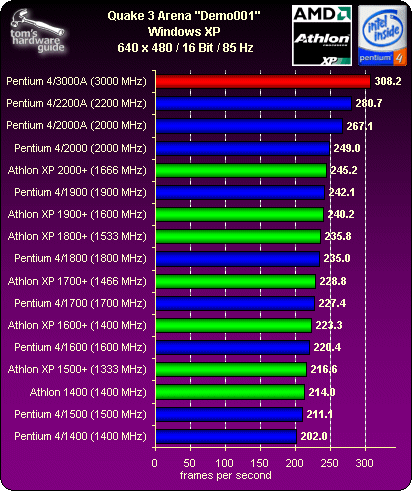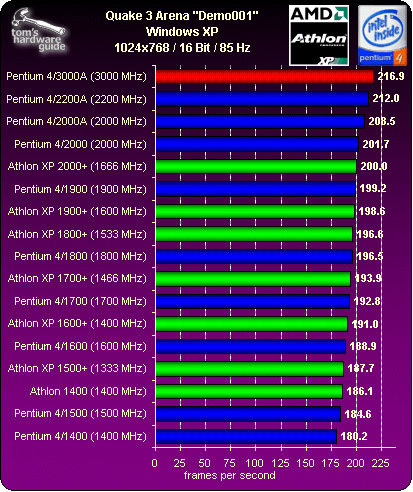Tom's Hardware Speed Project: Pentium 4, Over 3 GHz!
Benchmarks Under Windows XP: Pentium 4 At 3010 MHz
| OpenGL Performance | Quake 3 Arena "Demo 1" |
| Direct3D Performance | 3D Mark 2000 and 3D Mark 2001 |
| 3D-Rendering | Cinema 4D XL R6 |
| 3D-Rendering | SPECviewperf "Lightscape" |
| 3D-Rendering | Lightwave 7 |
| Audio-Encoding MP3 | Lame MP3 Encoder |
| Video-Encoding MPEG-2 | Pinnacle Studio 7 |
| Video-Encoding MPEG-4 | XMpeg 4.2a und Divx 4.2 |
| Office Performance | Sysmark 2001 |
| Archiving | WinACE 2.04 |
| Linux Kernel Compiling | Suse Linux 7.3 (Kernel 2.4.13) |
| SiSoft Sandra 2001 | CPU and Multimedia Bench |
We used a total of 17 different benchmark tests in order to give you a complete picture of what the extremely overclocked Pentium 4 can do. The benchmark results of 17 of the latest processors from AMD and Intel give you a comparative overview. The OpenGL performances are measured through various Quake 3 tests; the Direct3D performance from the DirectX package is measured with 3D Mark 2000 (based on DirectX7) and 3D Mark 2001 (based on DirectX 8). A comprehensive test scenario is created by a variety of benchmarks for MPEG encoding - with the help of the Lame MP3 Encoder, a 178 MB WAV file is converted to the MPEG-1 Layer 3 format. One of the established standards is our MPEG-4 test, in which data from a commercial DVD-ROM is converted into MPEG-4 via Xmpeg and the Divx codec. In addition, an MPEG-2 file is created with tPinnacle Studio 7 video editing software. We have been using the professional Lightwave package version 7b from Newtek to evaluate rendering performance for a while. Also important for practical applications is data-packing; we use WinACE-Packer for this. Compiling the newest Linux Kernel 2.4.13 has long been part of our standard repertoire. In order to test office performance, the Sysmark 2001 benchmark is used.
OpenGL Performance: Quake 3 Arena
In the two time demo runs from Quake 3 Arena, the Pentium 4/3000 achieves an outstanding frame rate.
Get Tom's Hardware's best news and in-depth reviews, straight to your inbox.
Current page: Benchmarks Under Windows XP: Pentium 4 At 3010 MHz
Prev Page Test Setup Next Page Direct3D - DirectX 7: 3D Mark 2000-
godbrother Wow, I can't belive this was written in 2002, still no replies :D C'mon fellas. It's closing in on 8 years.Reply -
youssef 2010 and now we have 6-core i7-980X that can be overclocked using the stock cooler.And the intel atom can beat the 2200MHz chip in the benchmark(the dual-core atom, of course).But these days were good.I was still pretty much an ignorant in the computer field.Reply

